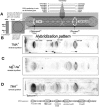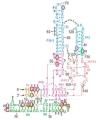Microarrays for identifying binding sites and probing structure of RNAs
- PMID: 25505162
- PMCID: PMC4288193
- DOI: 10.1093/nar/gku1303
Microarrays for identifying binding sites and probing structure of RNAs
Abstract
Oligonucleotide microarrays are widely used in various biological studies. In this review, application of oligonucleotide microarrays for identifying binding sites and probing structure of RNAs is described. Deep sequencing allows fast determination of DNA and RNA sequence. High-throughput methods for determination of secondary structures of RNAs have also been developed. Those methods, however, do not reveal binding sites for oligonucleotides. In contrast, microarrays directly determine binding sites while also providing structural insights. Microarray mapping can be used over a wide range of experimental conditions, including temperature, pH, various cations at different concentrations and the presence of other molecules. Moreover, it is possible to make universal microarrays suitable for investigations of many different RNAs, and readout of results is rapid. Thus, microarrays are used to provide insight into oligonucleotide sequences potentially able to interfere with biological function. Better understanding of structure-function relationships of RNA can be facilitated by using microarrays to find RNA regions capable to bind oligonucleotides. That information is extremely important to design optimal sequences for antisense oligonucleotides and siRNA because both bind to single-stranded regions of target RNAs.
© The Author(s) 2014. Published by Oxford University Press on behalf of Nucleic Acids Research.
Figures







Similar articles
-
Binding of short oligonucleotides to RNA: studies of the binding of common RNA structural motifs to isoenergetic microarrays.Biochemistry. 2009 Dec 8;48(48):11344-56. doi: 10.1021/bi901264v. Biochemistry. 2009. PMID: 19835418
-
Facilitating RNA structure prediction with microarrays.Biochemistry. 2006 Jan 17;45(2):581-93. doi: 10.1021/bi051409+. Biochemistry. 2006. PMID: 16401087 Free PMC article.
-
Genome-Wide Probing of RNA Structures In Vitro Using Nucleases and Deep Sequencing.Methods Mol Biol. 2016;1361:141-60. doi: 10.1007/978-1-4939-3079-1_9. Methods Mol Biol. 2016. PMID: 26483021
-
Novel multistranded, alternative, plasmid and helical transitional DNA and RNA microarrays: implications for therapeutics.Pharmacogenomics. 2009 May;10(5):895-914. doi: 10.2217/pgs.09.27. Pharmacogenomics. 2009. PMID: 19450135 Review.
-
Exceptionally stable nucleic acid hairpins.Annu Rev Biophys Biomol Struct. 1995;24:379-404. doi: 10.1146/annurev.bb.24.060195.002115. Annu Rev Biophys Biomol Struct. 1995. PMID: 7545040 Review.
Cited by
-
Comprehensive profiling of the ligand binding landscapes of duplexed aptamer families reveals widespread induced fit.Nat Commun. 2018 Jan 24;9(1):343. doi: 10.1038/s41467-017-02556-3. Nat Commun. 2018. PMID: 29367662 Free PMC article.
-
Structural determinants for alternative splicing regulation of the MAPT pre-mRNA.RNA Biol. 2015;12(3):330-42. doi: 10.1080/15476286.2015.1017214. RNA Biol. 2015. PMID: 25826665 Free PMC article.
-
Microscale Objects via Restructuring of Large, Double-Stranded DNA Molecules.ACS Appl Mater Interfaces. 2018 Dec 5;10(48):41215-41223. doi: 10.1021/acsami.8b18157. Epub 2018 Nov 19. ACS Appl Mater Interfaces. 2018. PMID: 30403478 Free PMC article.
-
Microarray-based technologies for the discovery of selective, RNA-binding molecules.Methods. 2016 Jul 1;103:188-95. doi: 10.1016/j.ymeth.2016.04.022. Epub 2016 Apr 19. Methods. 2016. PMID: 27109057 Free PMC article. Review.
-
Complementary oligonucleotides regulate induced fit ligand binding in duplexed aptamers.Chem Sci. 2017 Mar 1;8(3):2251-2256. doi: 10.1039/c6sc03993f. Epub 2016 Dec 8. Chem Sci. 2017. PMID: 28507681 Free PMC article.
References
-
- Pirrung M.C., Southern E.M. The genesis of microarrays. Biochem. Mol. Biol. Educ. 2014;42:106–113. - PubMed
-
- Augenlicht L.H., Kobrin D. Cloning and screening of sequences expressed in a mouse colon-tumor. Cancer Res. 1982;42:1088–1093. - PubMed
-
- Schena M., Shalon D., Davis R.W., Brown P.O. Quantitative monitoring of gene-expression patterns with a complementary-DNA microarray. Science. 1995;270:467–470. - PubMed
Publication types
MeSH terms
Substances
Grants and funding
LinkOut - more resources
Full Text Sources
Other Literature Sources

